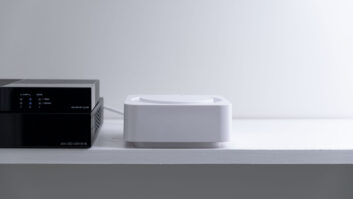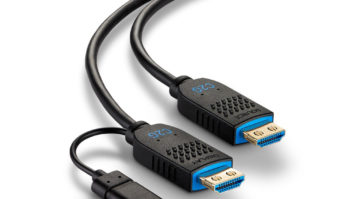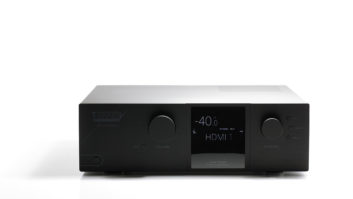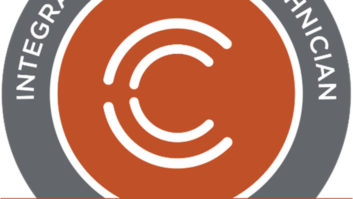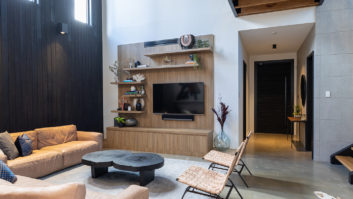The Telecommunications Industry Association 570-B cabling standard serves as a decisive reference for high-quality residential system cabling installations, which now also include whole-home audio, control, and security systems cabling. Implementing this standard helps installers, builders, and equipment manufacturers maintain a good reputation while building credibility with their customers.
A quality installation is proven to all stakeholders when the qualification testing approach, detailed by the standard, economically documents that cabling installations support technologies to be used in the home. For example, the homeowner will have printed results that the cabling supports Ethernet up to gigabit speeds, Firewire, and VoIP.
Qualification testing lowers installation costs by significantly reducing callbacks and making it possible to charge for roll-backs that result from damage done to cabling after the installer has already left the job. Because qualification testing was completed at the finish stage of the project and documentation was given to the builder and the homeowner, it makes it much easier to determine what caused the fault should an issue arise. Most important, the new standard improves customer satisfaction; qualified cabling systems ensure high-quality, reliable systems that eliminate a negative experience, and bolster the reputation of the installer.
The complexity associated with residential cabling is growing at a rapid rate as more new and renovated homes are wired with Category 5e or 6 and RG6 coax for data and voice, home entertainment, security, DSL and cable modems, and specific gauge wire for some speaker, control, and alarm systems. The much broader range of bandwidth-intensive applications in the home, especially those in the future, present unique cabling installation challenges. Residential cable installers must be knowledgeable of the wide range of low-voltage cable types and must also implement their work within a much broader installation process that, many times, presents problems later found in the cabling.
The potential for problems exists throughout the residential installation process. Cabling is typically installed at rough in. At this point, installers need to be careful not to apply too much tension on cable pulls, ensure they are sufficiently separated from electrical cables, and that the cable has not been punctured by a nail or screw or knotted. Careful inspection of the cable and verification of its continuity should be performed just after the rough-in stage because installers still have the chance to replace the cable if necessary. After the home is insulated, sheet rocked, and painted, the installer goes back to place the faceplates (and connectors if not done during rough-in for a verification check) at the finish stage and needs to qualify the cabling. Qualification testing is necessary to ensure that a sheet rock screw had not found its way into the cable and that the cabling will support intended networking technologies.
The requirements of residential systems installers differ from commercial data cabling installation that has up to now driven the test instrument market. Commercial data cabling networks typically require only one or two types of cabling that must support a very high level of network traffic. So for commercial networks, certification to performance standards such as TIA-568-B is absolutely necessary to guarantee the cabling systems ability to support the required bandwidth and future applications. Certification requires making very precise measurements and then comparing the results to predefined standards requirements. In the case of a Category 5e permanent link, a field test instrument will make many thousands of measurements across a spectrum of frequencies and compare them to rigid standards specifications to make a pass/fail determination.
The situation is very different for resident systems. The bandwidth requirements are not as intensive and a wider range of cabling and technologies need to be supported. Until recently, residential installers have had no all-in-one solution to verify and trouble-shoot the many different types of cabling used in a typical residential installation. At the same time, the certification testing tools that have been designed for commercial cabling installation are often too expensive and complicated for residential use.
Most installers rightfully feel that certification is overkill for a residential installation. Without any viable alternative they frequently wire and walk, installing the cable and leaving without testing. The risk, of course, is that after the house is completed, the owner moves in and the cabling doesnt work. According to a survey of EH Expo 2005 attendees, and one-on-one interviews with top residential installers, 10 percent of installations require the installer to return to the job. Callbacks are not only costly, they also lead to stress, time wasted, and pointing fingers. Most callbacks are due to improperly terminated cables and jacks or cabling damage caused by other contractors.
Without testing, there is no easy way to prove the root-cause of a problem. Often, the cable installer, to maintain the goodwill of the customer, goes back to the scene at no additional charge to see if there truly is a cabling problem, even though the average cost of a callback is slightly over $200. The builder is unhappy not only because he has to spend time dealing with the problem, he now also the focus of an equally unhappy homeowner. In many cases, even cabling hardware manufacturers may get involved by sending out their staff to prove that their products performed as promised.
The TIA has been hard at work addressing these issues by hammering out a revised residential cabling standard. The revised standard includes cabling requirements for voice, networking, security, whole-home audio, and control systems. The new standard covers both testing and documentation, and sets up a three-tier testing scheme.
The first stage is visual inspection of the recently pulled-in cable while the walls are still open. The visual inspection is intended to detect obvious problems such as kinks, knots, and bend radius conformance and ensure that correct separations are kept from electrical wiring and other communications cabling to prevent interference. The second stage is called verification, and is performed just after rough in or installation of insulation. It involves checking the wire map and cable length, which can be done with an inexpensive tester, or a qualification tester. This proves that the installed cable indeed has continuity and that a stray nail or screw has not found its way into the cable.
The third stage is qualification of the cabling after finish-out. This is the time when the jacks are placed in the faceplate and securely mounted to the wall. The qualification test involves testing the cable to ensure that technologies, such as 1000BASE-T or VoIP, will be supported by the cabling. According to the standard, this can be done by connecting actual networking equipment or with test equipment designed for this purpose. The qualification stage is the most crucial element of the TIA-570-B standard, because this is the last chance to fix a problem before it requires an expensive rollback.
Qualification testing as outlined in the TIA-570-B standard provides an economical way to test and document that cabling installations will support the technologies desired by homeowners. Qualification testing supports all low-voltage residential wiring including data cables, coax cables, telephone wire, security wire, and speaker wire. It differs from other standards in that it provides support for the diverse cabling media types common to residential environments.
The key to the value of the TIA-570-B standard is the availability of a new generation of qualification testers designed to meet the needs of residential systems installers. Qualification testers, unlike verification testers, document that cabling systems are installed properly and will perform reliably. Additionally, they, like the Fluke Networks CableIQ Residential Qualifier, require minimal training and have powerful installation verification and troubleshooting capabilities that replace multiple tools for testing and ID-tagging of all voice, data, video, audio, and security cables and outlets, including toning.
This new generation of instruments is considerably less expensive and easier to use than instruments designed for certifying cabling installations. It differs in its ability to support not just data cabling but all types of cabling typical used in residential installations. This category of test tool costs around $1,000, so it only takes the elimination of three to four rollbacks to pay for it. The new generation of testers provides even the most novice tech with the vision to see what speeds cabling can support, test every piece of cabling installed in the home, and provide documentation that can be used to prove that the cabling worked when the installer left the house.
New testers can improve every stage of the residential systems installation process. The new testers can verify end-to-end continuity and allow the installer to trace the cable pathway, even behind walls. An active network can be tested simply by plugging the test instrument into the jack while a passive network is tested by plugging in remote modules to the other end of the cable.
The installer might typically walk around the house and install modules into each outlet, then go back to the distribution center and test each outlet in sequence. A discovery mechanism can be used to determine what is on the other end of the line, making it easy to determine, for example, that a data circuit has been placed on a telephone jack. For each outlet, the test instrument determines the cablings ability to support a variety of technologies. The instrument can easily produce a wire map of the entire bridged telephone cabling installation, making it easy to identify shorts, opens, improper jacks, etc.
After the house is insulated, sheet rocked and painted, the installer goes back to install the faceplates at the finish stage and then needs to re-qualify. Re-qualification is necessary to find out if a sheet rock screw found its way into the cable, or if cabling performance was hurt by moving the jack into the faceplate at finish-out.
Finally, the instrument generates a report that can be saved on a hard drive and printed out for attachment to the distribution center. In case a problem appears later, the report can be used to verify that the cable was working when the installer left the site, making it possible to charge for the roll-back.
Qualification testing provides the installer a more affordable way to document that residential cabling installations are defect-free and will meet homeowner expectations for quality and reliability. The creation of documentation helps prove the performance of every cabling run and ultimately can reduce installation costs and protect your business.
Bob Jensen, RCDD, is the standards and technology development manager for Fluke Networks. He has more than 25 years of technical and managerial experience in the telecommunications industry.


